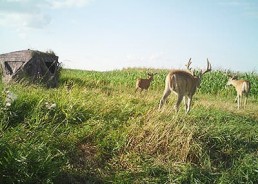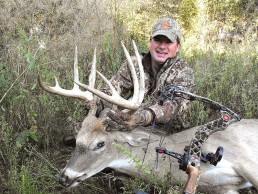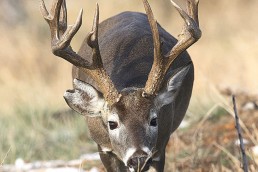The Inside Scoop on Taking Huge Farm-country Bucks
SHARE THIS POST
There are a few things I wish somebody would have told me when I first started bowhunting Great Plains whitetails.
So much of the information written or spoken about whitetail hunting originates from big woods hunting. While there are lessons that can be learned or reapplied wherever deer roam, tactics and strategies can change dramatically as the terrain changes.
What makes whitetails such remarkable animals is their adaptability. What I found as I picked up a bow and pursued whitetails is that many of the concepts and information I absorbed as a beginning bowhunter were irrelevant for my open-country hunting. Wide-open farm country creates different challenges.
Farther east, where the landscape is much more wooded, deer densities are much higher. (Deer live in a much smaller area and there are more deer per square mile.) In many places, 80 acres is plenty of land to hunt deer on, but as you get out into much more wide-open terrain, you typically need more land to hunt, because deer roam so much more and the deer population densities are much lower. Wide-open fields of cropland are broken up with woodlots, tree rows, or slough bottoms, any of which provide cover.
Because of the terrain to the east, scouting is often done over foot plots cleared in the woods or using trail cameras on pinch points. Trail cameras are an invaluable scouting tool but in some ways all a camera tells you is that the deer is alive and you might be able to figure out what direction the deer is coming from at what time. There are still a lot of clues missing when it comes to trying to kill a particular deer.
One painful lesson I have learned is that I can never assume anything with deer in regards to where they are bedding or the route they are taking from point A to point B. I guess wrong 90 percent of the time. Now I have gotten into the habit of using cameras to scout and finding a specific deer, and I use a camera to monitor a specific spot when I get ready to hunt. But the information I gather from scouting with optics is really how I can put a solid plan together.
When I was younger and more inexperienced, a common mistake I made was to assume a bedding area or travel route just from the intel gathered from trail cameras and unintentionally hunting with wrong or compromised winds. Now I am a lot more methodical and patient. I don’t move in on a deer until I know enough details about its tendencies. I bide my time until the wind is right and I can get in without detection.
A gamble I sometimes struggle with is whether I can get out, or get winded by deer after they pass my location. So there are times when there are high risk, high reward situations where you have one good chance to kill a particular deer––but if you don’t kill that deer that night, you compromise the spot. When I am in doubt, I sit on a hill and scout. There are many challenges to hunting this wide-open terrain but one advantage more hunters should capitalize on is to rely less on trail cameras and more on a spotting scope.
What is fascinating, especially during the first half of the season, is how much these bedding areas get influenced by bugs like gnats and mosquitoes. Much of the heavier cover is around water or is wet. An example would be a slough bottom or drainage. The cover can be really thick and look good, but if the bugs are bad, deer will often bed up higher where the wind can blow through.
It’s also interesting to see that deer have different personalities and preferences. Some bucks will prefer to bed in standing corn, for example, when it is really hot. Other bucks seem to be more sensitive when their antlers are in velvet and seem to stay away from anything that touches their antlers. These preferred bedding areas can change or shift through the season.
Food sources can also change, but you really can’t go wrong focusing on soybean fields if they are available, at least until the leaves yellow. Small grains and crops that flower, like canola, can also get hit. Corn is sometimes used as a bedding area early in the season, but what becomes really interesting is the travel routes deer choose. How deer move from point A to point B can be somewhat predictable, in that they always take the path of least resistance and like to feel hidden. Ravines or dips that hide deer in the terrain, or edges that create easy walking, are often the preferred route.
Are you enjoying this post?
You can be among the first to get the latest info on where to go, what to use and how to use it!
One thing I have found when checking trail cameras is that if I check the cameras too often and create a trail to my camera, I can actually disrupt the route I want the deer to travel. They can begin to follow my route to the camera! This can create a few challenges when planning a fast and quiet route in and out of your stand or blind. If you make a trail, remember that deer will also begin to follow that trail. Because of the openness of this terrain, we do get our share of wind, so the best thing I have found for getting into location is to go in during the middle of the day and use the wind to cover my noise––and stay away from the easiest route. Picking through heavier cover or taller vegetation without breaking or beating down the vegetation to form a trail has been my most effective strategy.
The age-old challenge of harvesting a mature buck is catching that deer on its feet during shooting hours. The farther you are away from where a buck beds, the later the pics are going to be. When I started bowhunting, I would get pictures of impressive bucks on camera at night, and hope that if I hunted that location long enough I would get a chance during the day. Far shot and the more you hunt a spot the worse it gets. What also happened was that I would get daytime shots of a buck during the summer scouting and then as the summer progressed, the deer would become nocturnal.
I don’t believe that anymore. These deer that tease you in the summer and become nocturnal aren’t changing their daily timeline; they changed their bedding locations, and one of the reasons deer often shift where they bed is human activity. If you want to make that deer go “nocturnal,” check the trail camera often and make your presence known. The deer still moves before dark but now, instead of bedding 100 yards away, he is 300 yards or a mile away. This is why the spotting scope is so invaluable when scouting.
Mature bucks are aware enough to detect human intrusion, so the key to killing a deer in my mind is to hide your presence. With that being said, disguise your presence with farming and ranching activity. The worst thing to do, in my mind, is to try sneaking in and out on foot. If you do, spray down and wear rubber boots. What works best is a loud, obvious vehicle. If you have to mow a shooting lane or check a trail camera, don’t try to hide or be sneaky. Drive up and drive out, if the terrain allows. The less your feet touch the ground, the better. The reality is that there are people spraying crops all summer. There are people driving ATVs checking fence. Deer get used to those types of human activity.
Remember that the landscape goes through changes. Don’t overthink the deer about clearing a shooting lane or trimming branches. Somebody could drive right by your stand with a round bale hayer and deer will be walking by the bales the next day. Deer know what tractors are. If you try to sneak around too much, you smell different and offer an intrusion that the deer aren’t used to. Become more obvious and use a vehicle whenever possible. With that being said, I like to drive as slowly and as quietly as possible in areas that are really secluded and I always like to do my work in regard to setting up blinds or checking cameras in the middle of the day. Wind or rain makes the intrusion even more hidden.
The biggest challenge of this open terrain is the lack of trees. I hunt out of a treestand whenever I can, because there are many advantages. Good field of view, great for watching around you so that if you are in the wrong spot, you gather additional intel as you sit and watch. Good for blowing your scent away from the area. Movement is out of line of sight for most deer. But especially in this type of terrain, good luck finding the right tree in the right spot. So often, I have to rely on ground blinds.
The versatility of ground blinds makes them a valuable tool when hunting farm country whitetails. Don’t worry about hiding it or trying to make it blend in, just put it exactly where it needs to be to kill a deer. The deer see it and after passing the smell test, they determine that it is just another bale or anhydrous tank. I often leave ground blinds out for long periods of time, so for that reason I like to use the heavier duty Elite Hunter Blind by Clam.
This terrain creates challenges but also offers great rewards. There are great deer available in these habitats, and while whitetails will always offer ample doses of humility, these deer can be figured out with the right strategies.
Jason Mitchell is a well-known guide who founded Mitchell’s Guide Service on Devils Lake, North Dakota. Long-time member of the Perch Patrol ice-fishing guide service, at home guiding hunters and anglers, he hosts Jason Mitchell Outdoors television show, and writes frequently for MidWest Outdoors.
MWO
SHARE THIS POST
You may also like...
Did you enjoy this post?
You can be among the first to get the latest info on where to go, what to use and how to use it!
Jason Mitchell
Jason Mitchell was a top walleye guide on Devils Lake, N.D. for nearly 20 years. Today, Mitchell produces the Jason Mitchell Outdoors TV program. Visit jasonmitchelloutdoors.com for more.


